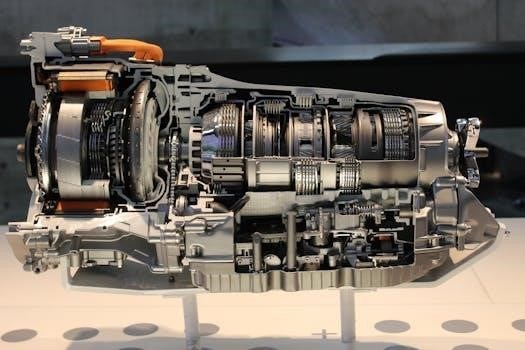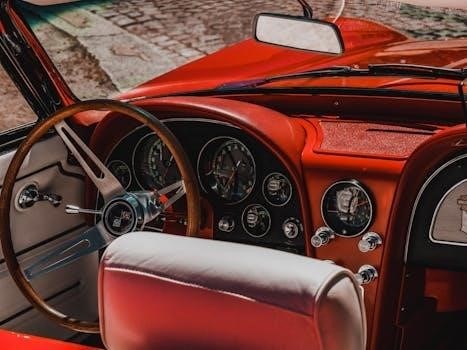
torque converter on a manual transmission
Torque Converter in Manual Transmissions⁚ An Overview
The integration of a torque converter into manual transmissions presents a unique concept. This combines the benefits of both systems, potentially offering smoother operation and enhanced torque multiplication in specific applications.
What is a Torque Converter?
A torque converter is a fluid coupling device typically found in automatic transmissions. It transfers rotational power from an engine to a driven load, using fluid dynamics instead of a direct mechanical connection. Within the torque converter, there are three main components⁚ an impeller, a turbine, and a stator. These components work together to multiply torque, particularly at lower engine speeds, to drive the vehicle’s wheels. It allows the engine to continue running even when the wheels stop.
Functionality and Purpose
Torque converters serve to smoothly transmit engine power to the transmission. They do this by using fluid coupling, and also multiplying torque. This is especially useful at lower speeds, or under heavy load conditions.
Role in Automatic Transmissions
In automatic transmissions, the torque converter is essential, replacing the mechanical clutch found in manuals. It allows the engine to continue running when the vehicle stops, providing smooth power transfer during acceleration. By using fluid coupling, the torque converter multiplies engine torque, enhancing performance. This design enables automated gear changes and reduces the need for driver input in shifting.
Clutch Replacement in Manuals
Integrating a torque converter into a manual transmission involves replacing the conventional clutch system. The setup typically includes a locking torque converter, a variable vane oil pump, and a clutch pack to operate as the manual clutch system would. Computer-controlled valve bodies manage the system, providing automated clutch engagement and disengagement. This innovative approach aims to blend the control of manual transmissions with the smoothness of automatics.
The Concept of Combining Torque Converters with Manual Transmissions
The idea merges the control of a manual gearbox with the fluid coupling of a torque converter. This aims to mitigate driveline shock and improve torque delivery, especially in demanding situations.
Addressing Driveline Issues
Torque converters in manual transmissions can substantially reduce stress on the driveline. The fluid coupling absorbs shocks from the engine and transmission, lessening the impact on gears, shafts, and other components. This is particularly beneficial in high-torque applications or situations where abrupt shifts or load changes are common. By dampening these forces, the lifespan of the driveline components can be extended, and the overall reliability of the vehicle improved, reducing maintenance costs and downtime. Smoother power delivery also enhances the driving experience.
Extreme Application Scenarios
The torque converter in manual transmissions shines in extreme applications, such as off-road racing, heavy-duty towing, and specialized industrial vehicles. The torque multiplication at low speeds is crucial when overcoming obstacles or pulling heavy loads. In off-road racing, the ability to smoothly modulate torque prevents wheel spin and maintains momentum. For towing, it allows for controlled starts on inclines. Industrial vehicles benefit from the increased power and durability. This setup offers a robust solution where traditional manual transmissions may struggle, providing enhanced performance and reliability under demanding conditions.
How a Torque Converter Works with a Manual Transmission
Integrating a torque converter with a manual transmission involves replacing the clutch with a locking torque converter system. This system uses a computer-controlled valve body to manage fluid flow and lock-up, providing unique operational characteristics.
Locking Torque Converter System
A locking torque converter system modifies a manual transmission by replacing the traditional clutch with a torque converter. The key feature is its ability to “lock up,” creating a direct mechanical connection between the engine and transmission. This lock-up eliminates the fluid slippage inherent in standard torque converters, enhancing efficiency, especially at higher speeds. This setup can provide a unique blend of torque multiplication at low speeds, similar to an automatic, and the direct control and feel of a manual transmission when locked.
Computer-Controlled Valve Body
In a manual transmission setup utilizing a torque converter, a computer-controlled valve body plays a crucial role. This sophisticated component manages the hydraulic fluid flow within the torque converter, dictating its behavior. The valve body allows for precise control over the torque converter’s lock-up function, enabling the system to switch between fluid coupling and direct mechanical connection based on various parameters, such as engine speed, throttle position, and vehicle speed. This electronic management optimizes performance and efficiency by adapting to different driving conditions.

Advantages of Using a Torque Converter in a Manual Transmission
Integrating a torque converter into a manual transmission offers benefits, including enhanced low-speed torque. It also makes for smoother operation, reducing drivetrain shock and improving overall drivability, especially in demanding scenarios.
Torque Multiplication at Low Speeds
One significant advantage of using a torque converter with a manual transmission is the torque multiplication achieved at lower engine speeds. Unlike a traditional manual transmission that relies solely on engine output and gear ratios, a torque converter multiplies the engine’s torque. This means that even at low RPMs, the transmission receives significantly more torque than the engine produces, resulting in improved acceleration and pulling power from a standstill. This is particularly useful in applications that require high initial torque, like towing or off-roading.
Smoother Operation
Beyond torque multiplication, a torque converter can drastically improve the smoothness of a manual transmission. The fluid coupling within the torque converter absorbs shocks and vibrations from the engine, leading to less jerky gear changes. It also eliminates the need for precise clutch engagement, making the vehicle easier to drive, especially in stop-and-go traffic. This results in a more comfortable and refined driving experience compared to the abruptness that can sometimes characterize traditional manual transmissions, especially for less experienced drivers. The torque converter essentially acts as a buffer.
Disadvantages and Challenges
Despite potential benefits, integrating a torque converter with a manual transmission presents notable challenges. These include drive disconnection issues and less than optimal torque delivery at lower speeds, impacting overall performance and efficiency.
Drive Disconnection Issues
One significant challenge in combining a torque converter with a manual transmission lies in achieving complete drive disconnection. Unlike a traditional clutch, a torque converter doesn’t fully separate the engine from the transmission. This incomplete separation can lead to “creep” at idle. This requires careful design considerations. Furthermore, this can complicate shifting, especially at low speeds, potentially affecting the smoothness and responsiveness of the manual transmission system, demanding sophisticated control mechanisms.
Torque Delivery Below Stall Speed
A core limitation arises from the torque converter’s behavior below its stall speed. Below this speed, the torque converter provides limited torque multiplication, potentially leading to sluggish performance. In a manual transmission, this can translate to a lack of responsiveness during initial acceleration or when maneuvering at very low speeds. It necessitates careful matching of the torque converter characteristics to the engine’s powerband to mitigate this issue.

Performance Implications
Integrating a torque converter into a manual transmission has significant effects. These may include improved acceleration due to torque multiplication. But, it also introduces complexities affecting overall vehicle performance and driver experience.
Potential Improvements in Acceleration
The primary advantage of employing a torque converter in a manual transmission setup lies in its ability to multiply torque at lower engine speeds. This characteristic can translate to enhanced acceleration, particularly from a standstill or during low-speed maneuvers. The torque converter effectively boosts the engine’s output, providing more power to the wheels and improving the vehicle’s responsiveness. This boost can result in quicker 0-60 mph times and a more engaging driving experience.
Comparison with Traditional Manual Transmissions
Examining the contrast between traditional manual transmissions and those augmented with torque converters highlights key differences. These include the method of engagement, driver control levels, and the overall driving experience offered by each system.
Clutch vs. Torque Converter
Traditional manual transmissions employ a clutch for direct engine-transmission engagement, demanding driver skill for smooth operation. Conversely, torque converters, common in automatics, use fluid coupling for smoother engagement but can introduce power loss; The integration of a torque converter into a manual aims to blend these characteristics. It seeks to automate gear changes, which provides a smoother ride and easier handling. It contrasts with a manual transmission, which requires the driver to manually shift gears.
Driver Control vs. Automated Assistance
Manual transmissions prioritize driver control, offering a direct connection to the vehicle’s mechanics. Drivers have the control to select gears and manage engine output. Integrating a torque converter introduces automated assistance, potentially smoothing gear changes and offering torque multiplication at low speeds. This shifts the balance, reducing the driver’s direct involvement in clutch operation. The torque converter can automate gear changes, providing a smoother ride and easier handling, particularly in stop-and-go traffic.

Alternative Technologies
Other technologies, like dual-clutch transmissions and CVTs, offer alternatives to both traditional manuals and torque converter automatics. These systems aim to blend efficiency, performance, and ease of use in different ways.
Dual-Clutch Transmissions (DCT)
Dual-clutch transmissions (DCTs) represent a significant advancement, offering a blend of manual and automatic functionality. Unlike traditional automatics with torque converters, DCTs use two separate clutches for odd and even gears. This allows for incredibly rapid gear changes, often faster than a human driver could achieve. DCTs provide a more direct and engaging driving experience compared to torque converter automatics, while still offering the convenience of automated shifting. They aim to bridge the gap between the involvement of a manual and the ease of an automatic.
Continuously Variable Transmissions (CVT)
Continuously Variable Transmissions (CVTs) offer a different approach to automated gear selection. Instead of fixed gears, CVTs use a system of belts and pulleys to provide a nearly infinite range of gear ratios. This allows the engine to operate at its most efficient point, regardless of vehicle speed. CVTs prioritize fuel economy and smooth acceleration. While not directly related to manual transmissions with torque converters, they represent an alternative technology focused on automated driving and efficiency.

Real-World Applications and Examples
The usage of torque converters in manual transmissions is not typical for road cars. However, some extreme applications like drag racing or specialized off-road vehicles can benefit from this hybrid system.
Uncommon in Road Cars
The integration of torque converters within manual transmissions remains uncommon in standard road cars. This is primarily due to the advantages offered by modern automatic transmissions, dual-clutch systems, and continuously variable transmissions. These options provide comparable smoothness and efficiency, often with better fuel economy, negating the need for a torque converter in a manual setup. The complexity and cost also contribute to its rarity in everyday vehicles.
Use in Extreme Applications
While uncommon in standard vehicles, torque converters paired with manual transmissions find use in extreme applications. These include motorsports, off-roading, and heavy-duty machinery. In these scenarios, the torque converter provides enhanced torque multiplication at low speeds, beneficial for overcoming challenging terrains or accelerating quickly. The manual transmission retains driver control over gear selection. This combination allows for a balance of power and precision, making it suitable for specialized needs.
Future Trends and Developments
Developments in electrohydraulic manual transmissions point to future innovations. These systems automate the clutch using electronic controls. This could potentially offer the benefits of both manual and automatic systems, without the traditional drawbacks.
Electrohydraulic Manual Transmissions
Electrohydraulic manual transmissions represent a cutting-edge advancement in automotive technology. These systems replace the traditional mechanical clutch linkage with an automated electrohydraulic system. This system offers a blend of manual control and automated assistance. The computer controls hydraulic actuators for smoother gear changes. This technology could potentially improve efficiency and reduce driver fatigue, offering a more refined driving experience. This innovation represents a step towards more sophisticated and versatile transmission systems.